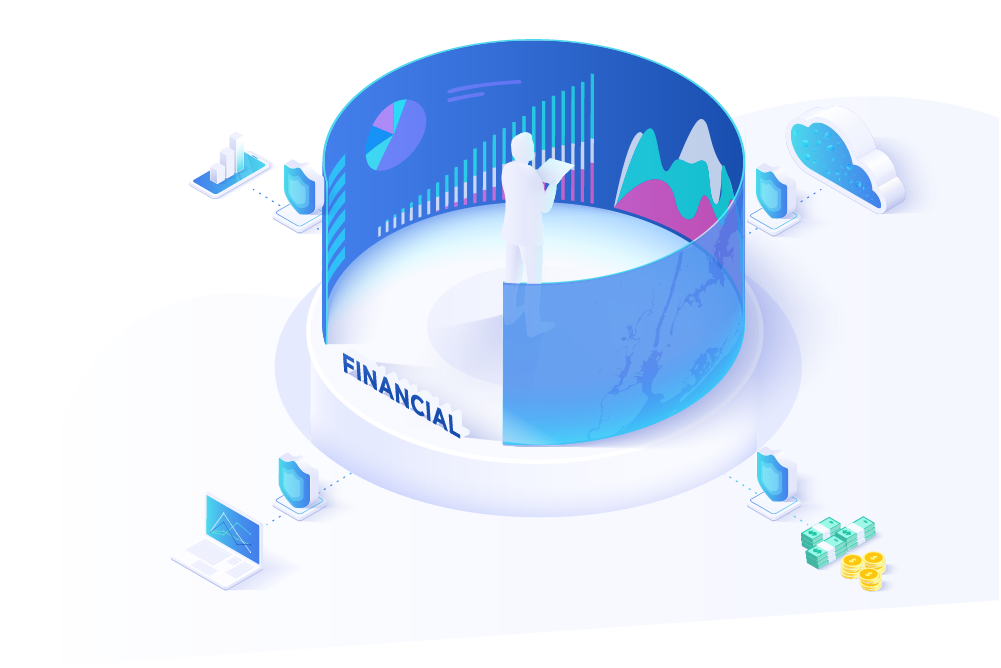Financial
ARX For Financial Services
In financial services sector, an average breach costs $210 per record, while a “mega breach” can cost up to $388 per record.
For any player in the financial services industry, data is the lifeline, which keeps them ahead of their competition. Poor security management and cyber-attacks can play havoc and only a proactive approach can help them secure their data.
A well-managed network security system is the need of the hour.
Threats
Challenges Galore
The financial services industry is privy to confidential and sensitive 'information and hence the industry has witnessed an increase in cyber-attack. Financial services institutions continue to face pressure to maintain high standards of data security, but they also face a lot of challenges in doing so:

High flow of information
The institutions share a huge amount of customer data to clients, employees, and even external partners. When there is so much of information being exchanged, it makes it difficult to protect data across multiple channels and mediums from varied sources.

Social Media
Financial institutions, like many other sectors, are harnessing the popularity of various social media platforms to build a brand and attracting new prospects. While it is useful, it also opens up channels for a cyber-attack.

Outdated systems
The financial services sector have realised the importance of an updated security system, but the cyber criminals are staying ahead by using sophisticated viruses, malware, and other techniques, outsmarting the best of data security technologies.

Employees who are unaware
Every institution has enabled automated Data Loss Prevention (DLP) solutions, but yet, the employees tend to leak important data, without knowledge most of the times, which is a big threat.
Solutions
The ARX Advantage
Single sign-on
Reports across the industry state that hacking and malware cause 75% of all data breaches in the sector.
Single sign-on
Reports across the industry state that hacking and malware cause 75% of all data breaches in the sector. It is easy to install and there are variations of it which is capable of carrying out malicious activities like downloading and dropping files, spyware attacks, keylogging, stealing passwords, etc. One of the reasons for this is that many of the financial institutions use multiple passwords, and since, there is a password for each process, the users tend to keep weaker passwords. Hence, they become an easy target.
There is an easy solution to fix this – using the same user id and password across all systems that you use. With the Single Sign-On (SSO), instead of a password for every application, users have one password to remember. With that single sign-on, they get access to all their applications. SSO assures that the users have a strong password. Also, it eliminates the need of a middleman to reset passwords time and again.
SSO makes the financial organisation more secure and life for the users easier. With SSO,
- We provide efficient, cost-effective and nimble identity infrastructure for IT at the organisation.
- Help users increase their productivity as they can seamlessly connect to multiple IT resources using the same credentials
- Mitigate risk of having lost, weak and shared passwords, by restricting access to services via various intelligent integrations like OAuth, SAML, and RSA
Enforce Strong Authentication
Certain attacks like Distributed Denial of Service (DDoS) have grown in size and frequency.
Enforce Strong Authentication
Certain attacks like Distributed Denial of Service (DDoS) have grown in size and frequency. DDoS attacks are defined as “those in which multiple compromised computer systems attack a target, such as a server, website or other network resource, and cause a denial of service for users of the targeted resource. The flood of incoming messages, connection requests or malformed packets to the target system forces it to slow down or even crash and shut down,thereby denying service to legitimate users or systems.”
A strong Multi-Factor Authentication (MFA) system can prevent such attacks. Traditional usernames and passwords can be stolen, and they’ve become increasingly vulnerable to brute force attacks like the DDoS. MFA creates multiple layers of security, resulting in efficient and diligent authentication. This ensures that the user requesting access is actually who they claim to be.
With MFA, a cybercriminal may steal one credential, but will be thwarted by having to verify identity in a different manner. MFA is an effective way to provide enhanced security for all your IT resources including cloud, on-premise and mobile.
- We help enable ‘MFA Everywhere’ on-premise with our strong integration support
- Starting from simple question-answers to fingerprint authentication and random pin generation device, any of these can be deployed for the MFA needs. All these can be configured using easy steps
User Management
Yet another alarming fact that the Bitglass report stated was that insider threats grew from 2.9% in 2018 to 5.5% in 2019 and accidental disclosures increased from 14.7% to 18.2% during the same time.
User Management
Yet another alarming fact that the Bitglass report stated was that insider threats grew from 2.9% in 2018 to 5.5% in 2019 and accidental disclosures increased from 14.7% to 18.2% during the same time. No company wants to believe that their own employees can contribute to cyber security incidents – intentional or accidental.
Leveraging automated user management streamlines role-based access control. Along with security suite features like authentication, access controls, privileges, entitlements, single sign-on & security policies and activity auditing across organisation, they can also create an error-free workflow as well, which will define the role of each and every employee.
With a better User Management,
- Bulk onboarding with exact required privileges can be performed easily
- Deboarding at ease without any worries
- With maker-checker workflow, one can be absolutely sure who is going to do what
Visibility, Detection and Response
In the recent past, the financial services firms have been reportedly hit by security incidents an astonishing 300 times more frequently than other industries.
Visibility, Detection and Response
In the recent past, the financial services firms have been reportedly hit by security incidents an astonishing 300 times more frequently than other industries. This is how valuable the data is that the financial services industry possesses. That is why risk mitigation becomes all the more important. The best way to lower risks is by detecting the attack earlier on and containing it.
This is where ARX can help. With lifecycle managed users, Access Controls and Authorisation Access can be easily managed and mapped. Along with a maker-checker workflow, the firm can keep track of who is doing what. With a clear visibility and detection mechanism in place, they can also respond to any threat, which otherwise could leave them exposed.
- One-stop shop for single login for users and one unified identity infrastructure for IT
- Integration with existing security tools
- Maker-checker workflow helps identify unusual and suspicious behaviours
- ARX API services can be used to enrich and extend the cyber security ecosystem; this is supported by helping to generate extensive reports for a deep dive into what is happening
- Can be easily integrated with the existing application with ARX using REST APIs for:
- Primary Authentication
- Multi-Factor Authentication
- User Management
- Password Management
- Validate and Get Entitlement
- Role-based access control –granular application-level access controls using entitlement policies that can be assigned to roles
- Users get access to resources based on their role. Access rights are grouped by role name,
and access to resources is restricted to users who have been authorised to assume the
associated role

Sign up for a
demo today!
Let us take you through our state of the art ARX suite of security services which will provide you with end to end security for user identification, authentication, single sign on, authorization and entitlements.




